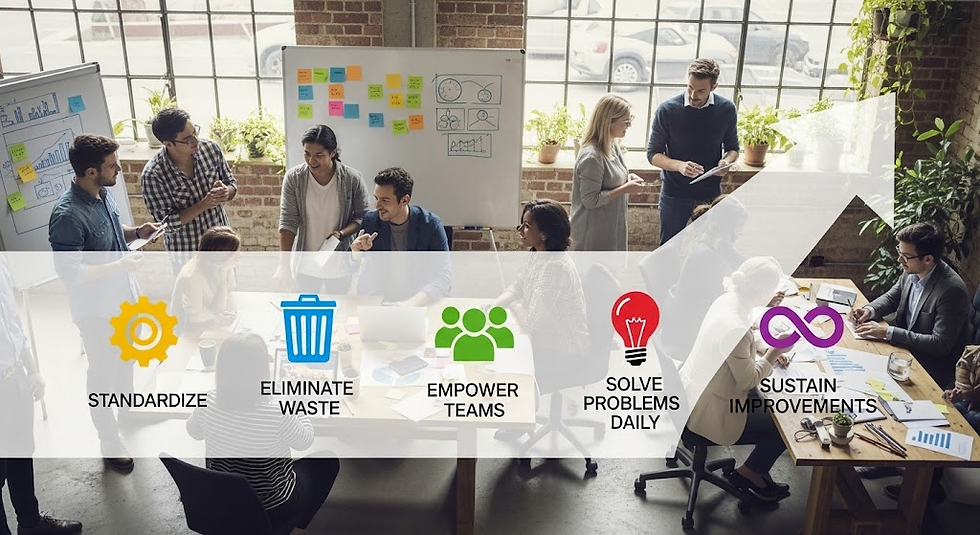How Kaizen Principles Enhance Performance Management
- KPM SMARTBiz

- Jun 6
- 4 min read
Updated: Jun 28
In today's fast-paced business environment, organizations are constantly seeking effective ways to improve performance and increase productivity. One approach gaining momentum is the application of kaizen principles.
Derived from the Japanese words "kai" (change) and "zen" (good), kaizen emphasizes continuous improvement in all aspects of life, particularly in business operations. By integrating these principles into performance management systems, companies can foster a culture of consistent development.
Understanding Kaizen Principles
Kaizen principles involve several key concepts aimed at enhancing efficiency, quality, and workplace morale. Implementing kaizen means involving all employees, from top management down to the front lines. This inclusive approach encourages everyone to be proactive in identifying problems and suggesting improvements.
For example, Toyota’s production system successfully integrates kaizen into its operational framework. This includes strategies such as Just-In-Time (JIT) manufacturing and Jidoka, which empower employees to stop the production line if a defect occurs. The kaizen model ensures that employees always strive for better methods and solutions.
The Role of Kaizen in Performance Management
Kaizen’s focus on continuous improvement directly aligns with performance management objectives. Performance management is about assessing and enhancing employee contributions to achieve organizational goals. By applying kaizen principles, organizations can streamline performance management processes in the following ways:
Clear Objectives: In a kaizen-oriented approach, clear and measurable performance objectives are set. These objectives must resonate with the organization's vision. For instance, an organization may set a goal to reduce production time by 10% over six months.
Employee Involvement: Performance management becomes a two-way street with employee input. Employees are encouraged to participate in evaluation discussions, allowing for suggestions and feedback. Research indicates that organizations that involve employees in decision-making see a 50% increase in engagement and productivity.
Frequent Reviews: Unlike traditional performance appraisals that may occur annually, a kaizen-based approach requires regular reviews. These short, frequent reviews allow organizations to quickly identify issues or obstacles and adjust performance goals accordingly.
Enhancing Feedback Mechanisms
Effective feedback mechanisms are crucial for performance management. Kaizen principles advocate for continuous feedback, allowing for incremental changes that can lead to significant enhancements over time.
360-Degree Feedback: This method involves collecting feedback from various sources - peers, managers, and subordinates. It provides a comprehensive view of an employee's performance, enabling individuals to identify their strengths and opportunities for improvement.
Real-Time Feedback: Implementing systems that provide instant feedback after tasks can significantly enhance learning. For example, using performance management software that offers feedback immediately after project completion allows employees to make adjustments right away.
Development of Personal Improvement Plans: Kaizen encourages employees to create personal improvement plans based on their feedback. Setting small, achievable goals can lead to substantial individual growth over time.
Creating a Culture of Continuous Learning
A key element of the kaizen philosophy is fostering a culture of continuous learning. When employees are encouraged to pursue personal and professional development, they become more engaged – leading to improved overall performance.
Training Programs: Organizations can implement ongoing training sessions to reinforce essential skills. These programs should be tailor-made to address specific performance gaps identified during the evaluation process.
Mentorship Opportunities: Establishing mentorship programs allows less experienced employees to learn from their peers. This not only increases knowledge transfer but also promotes a supportive work environment.
Encouraging Experimentation: Employees should feel safe to take risks and try new methods without fear of failure. Celebrating even unsuccessful attempts as learning opportunities encourages more innovative solutions to performance issues.
Measuring Effectiveness of Kaizen in Performance Management
The effectiveness of kaizen in enhancing performance management can be measured through several key performance indicators (KPIs). These metrics provide valuable data to pinpoint successes or areas needing improvement.
Employee Satisfaction Scores: Regular surveys can gauge employee engagement and satisfaction. An increase in scores typically reflects an improved work environment influenced by kaizen practices.
Productivity Rates: Monitoring productivity before and after kaizen implementation can showcase tangible improvements. For example, if a manufacturing line reduces waste and increases output, that’s a clear indicator of success.
Quality Metrics: Measuring the quality of outputs post-kaizen initiatives, such as defect rates or customer complaints, can provide insight into the effectiveness of continuous improvement strategies.
In conclusion, the application of kaizen principles within performance management systems paves the way for sustainable growth and efficiency. By fostering a culture of continuous improvement, organizations can not only enhance productivity and morale but also position themselves as leaders in their industry. For companies looking to embark on this journey, professional support through kaizen consulting services can offer the necessary expertise to implement these principles effectively.
Embracing the Future with Kaizen
As businesses evolve, the need for adaptive performance management strategies becomes increasingly critical. The integration of kaizen principles provides an agile framework that can respond to changing conditions while promoting a growth-oriented mindset. This proactive approach teaches organizations to see challenges as potential opportunities for enhancement rather than obstacles to performance. By committing to continuous improvement and empowering employees, businesses can thrive even in the face of adversity, securing a competitive edge that is invaluable in today’s marketplace.
In essence, kaizen principles not only enhance performance management but also transform organizational culture. By making small improvements consistently, organizations set themselves up for significant long-term achievements. The journey of continuous improvement is not merely about efficiency—it's about building a thriving workplace where everyone can contribute their best.








Comments